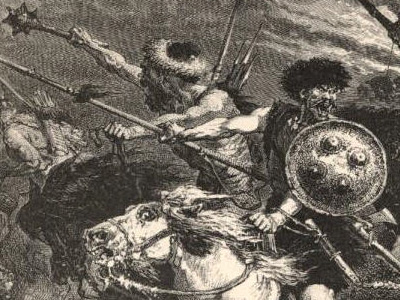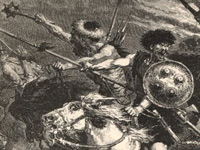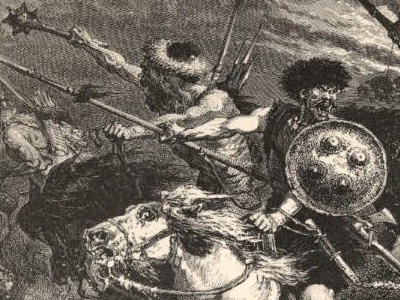Battle of Châlons (451 AD)

Outcome
The primary sources give little information as to the outcome of the battle, barring Jordanes. All emphasize the casualty count of the battle, and the battle became increasingly seen as a Gothic victory, beginning with Cassiodorus in the early 6th century.
Hydatius states:
"The Huns broke the peace and plundered the Gallic provinces. A great many cities were taken. On the Catalaunian Plains, not far from the city of Metz, which they had taken, the Huns were cut down in battle with the aid of God and defeated by general Aetius and King Theoderic, who had made a peace treaty with each other. The darkness of night interrupted the fighting. King Theoderic was laid low there and died. Almost 300,000 men are said to have fallen in that battle." - Hydatius, Chronicon, 150.
Prosper, contemporary to the battle, states:
"After killing his brother, Attila was strengthened by the resources of the deceased and forced many thousands of neighboring peoples into a war. This war, he announced as a guardian of Roman friendship, he would wage only against the Goths. But when he had crossed the Rhine and many Gallic cities had experienced his savage attacks, both our people and the Goths soon agreed to oppose with allied forces the fury of their proud enemies. And Aetius had such great foresight that, when fighting men were hurriedly collected from everywhere, a not unequal force met the opposing multitude. Although the slaughter of all those who died there was incalculable - for neither side gave way - it appears that the Huns were defeated in this battle because those among them that survived lost their taste for fighting and turned back home." - Prosper, Epitoma Chronicon, s.a. 451.
"The battle raged five miles down from Troyes on the field called Maurica in Campania." - Additamenta ad Chronicon Prosperi Hauniensis, s.a. 451.
"At this time Attila king of the Huns invaded the Gauls. Here trusting in lord Peter the apostle himself patrician Aetius proceeded against him, he would fight with the help of God." - Continuatio Codex Ovetensis.
"Battle was made in the Gauls between Aetius and Attila king of the Huns with both peoples and massacre. Attila fled into the greater Gauls." - Continuatio Codex Reichenaviensis.
The Gallic Chronicles of 452 and 511 state:
"Attila entered Gaul as if he had the right to ask for a wife that was owed to him. There, he inflicted and suffered defeat and then withdrew to his homeland." - Chronica Gallica Anno 452, s.a. 451.
"Patrician Aetius with king Theodoric of the Goths fight against Attila king of the Huns at Tricasses on the Mauriac plain, where Theodoric was slain, by whom it is uncertain, and Laudaricus the relative of Attila: and the bodies were countless. - Chronica Gallica Anno 511, s.a. 451.
The Paschale Chronicle, preserving a garbled and abbreviated passage of Priscus, states:
"While Theodosius and Valentinian, the Augusti, were emperors, Attila, from the race of the Gepid Huns, marched against Rome and Constantinople with a multitude of many tens of thousands. He notified Valentinian, the emperor of Rome, through a Gothic ambassador, "Attila, my master and yours, orders you through me to make ready the palace for him." He gave the same notice to Theodosius, the emperor in Constantinople, through a Gothic ambassador. Aetius, the first man of senatorial rank in Rome, heard the excessive daring of Attila's desperate response and went off to Alaric in Gaul, who was an enemy of Rome because of Honorius. He urged him to join him in standing against Attila, since he had destroyed many Roman cities. They unexpectedly launched himself against him as he was bivouacked near the Danubios river, and cut down his many thousands. Alaric, wounded by a saggita in the engagement, died.
Attila died similarly, carried off by a nasal hemorrhage while he slept at night with his Hunnic concubine. It was suspected that this girl killed him. The very wise Priscus the Thracian wrote about this war." - Chronicon Paschale, p. 587.
It is ultimately Jordanes' writing, whose passages were mentioned above, that leads to the difference in opinions in modern interpretations of the battle's outcome.
As a Roman victory
In the traditional account, modern scholars take a very direct interpretation of Jordanes, although usually with various points of contention. Modern scholars tend to agree that the battle took place on a long ridge, not a plain with a hill to one side. Hughes argues that the Huns deploy in the center, with their vassals on the wings, because they were expecting a Roman infantry center, with cavalry wings. This way Attila could pin down the center with the disorganized Hunnic style of warfare, while the majority of his troops focused on breaking one or both of the enemy flanks. However, Hughes argues that the Romans were expecting this, which is why he placed the Alans in the center of the formation, who were skilled cavalrymen and had advanced knowledge of how to fight alongside the Roman style of warfare. Bachrach also notes that Jordanes' point of placing the Alans in the center due to disloyalty is biased on Jordanes' part.
Jordanes' description of the battle, according to Hughes, takes place from the Roman perspective. Attila's forces arrived on the ridge first, on the far right side, before the Visigoths could take that position. Then Aetius' Romans arrived on the left side of the ridge, and repulsed the Gepids as they came up. Finally the Alans and the Visigoths under Thorismund fought their way up and secured the center of the ridge, holding it against Attila. However, Hughes differs in that he places Thorismund between the Alans and Visigothic main body, rather than on the Visigothic flank. MacDowall, for example, places Thorismund on the far right of the battlefield and states Thorismund's engagement was a skirmish just prior to the main clash. The final phase of the battle is characterized by the Gothic attempt to take the right side of the ridge, in which Theodoric is slain, the rest of his army unaware of his death. It is at this point that Thorismund located Attila's position in the Hunnic battle line, and attacked the Hunnic center, nearly slaying Attila himself and forcing the Hunnic center to retreat. Both armies fell into confusion as darkness descended, and neither side knew the outcome of the battle until the following morning.
After the battle, the allies decided what to do next, and resolved to place Attila under siege for a few days while they discussed the matter. Aetius allegedly persuaded both Thorismund and the Goths, and the Franks as well, to leave the battle and return home. Hughes argues that since the Franks were fighting a civil war in the Battle, and Thorismund had five brothers who could usurp his new-found position as king, that it is likely Aetius did advise them to do so. O'Flynn argues that Aetius persuaded the Visigoths to return home in order to eliminate a group of volatile allies, and argues that he let Attila escape because he would have been just as happy to make an alliance with the Huns as with the Visigoths. The majority of historians also share the view that at this point Attila's "aura of invincibility" was broken, and that Aetius allowed the Huns to retreat in the hopes he could return to a status of partnership with them and draw on the Huns for future military support. The battle, almost immediately afterwards, then became famous for its staggering death toll.
As a Roman defeat
Kim, in his recent work on the Huns, takes a radically different view of the battle's outcome. Kim suggests that, in fact, the entire battle is a play on the Battle of Marathon, with the Romans being the Plateans on the left, the Alans the weak Athenian center, and the Goths the Athenian regulars on the right, with Theodoric as Miltiades and Thorismund as Callimachus. The return home by the Goths to secure Thorismund's throne is the same as the return to Athens to protect it from sedition and the Persian Navy.
Kim also suggests a radically different outcome of the battle: his argument is mostly based on the description of the positions of various forces after the battle, which he believes to be the part that is actually factual. Thorismund and Aetius both lose track of their armies, both in the middle of the enemy army in the confusion of the night, with Aetius fearing that disaster had happened. He argues the important piece of information given is that the Huns were unable to near the Roman camp because of the archers positioned within it, stating that what really happened is that the Roman coalition had routed and the Huns had chased them back to their camps, not Attila being chased to his.
Kim uses this to build a new interpretation: after Theodoric is killed, the Gothic line routs and leaves a gap in the line for the Huns to exploit, making the Visigoths at fault for the disaster. He says that Jordanes tries to place the fault on the Alans, who bore the brunt of the battle in the center because they were the most reliable of the allied forces and a hindrance to Visigothic hegemony in the region at the time.
However, Kim's views have received a mixed reception among scholars of the period, with one reviewer noting that much of the text amounts to "a confused and confusing story, involving the rewriting of histories, genealogies and chronologies... exacerbated by strange and clumsy conflations." They therefore should be taken with skepticism.
HISTORY

RESOURCES
This article uses material from the Wikipedia article "Battle of the Catalaunian Plains", which is released under the Creative Commons Attribution-Share-Alike License 3.0.
© Stories Preschool. All Rights Reserved.









